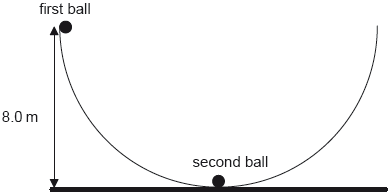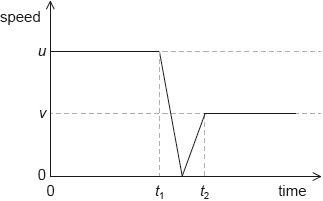| Date | November 2021 | Marks available | 1 | Reference code | 21N.2.SL.TZ0.1 |
| Level | Standard level | Paper | Paper 2 | Time zone | 0 - no time zone |
| Command term | Suggest | Question number | 1 | Adapted from | N/A |
Question
A ball of mass 0.250 kg is released from rest at time t = 0, from a height H above a horizontal floor.
The graph shows the variation with time t of the velocity v of the ball. Air resistance is negligible. Take g = −9.80 m s−2. The ball reaches the floor after 1.0 s.
Determine H.
Label the time and velocity graph, using the letter M, the point where the ball reaches the maximum rebound height.
State the acceleration of the ball at the maximum rebound height.
Draw, on the axes, a graph to show the variation with time of the height of the ball from the instant it rebounds from the floor until the instant it reaches the maximum rebound height. No numbers are required on the axes.
Estimate the loss in the mechanical energy of the ball as a result of the collision with the floor.
Determine the average force exerted on the floor by the ball.
Suggest why the momentum of the ball was not conserved during the collision with the floor.
Markscheme
H = «gt2 =» 4.9 «m» ✓
Accept other methods as area from graph, alternative kinematics equations or conservation of mechanical energy.
Award [1] for a bald correct answer in the range 4.9 - 5.1.
Award [0] if time used is different than 1.0 s.
M at 1.6 s ✓
«g =» 9.80 «ms−2» ✓
Accept 9.81, 10 or a plain “g”.
Ignore sign if provided.
concave down parabola as shown «with non-zero initial slope and zero final slope» ✓
Award [1] mark if curve starts from a positive time value.
Award [0] if the final slope is negative.
« loss of KE is » «J» ✓
Award [1] mark for an answer in the range 8.7 - 9.5.
✓
Fnet = «» «N» ✓
N «N» ✓
Allow ECF for MP2 and MP3.
there is an external force acting on the ball
OR
some momentum is transferred to the floor ✓
Allow references to impulse instead of force.
Do not award references to energy.




